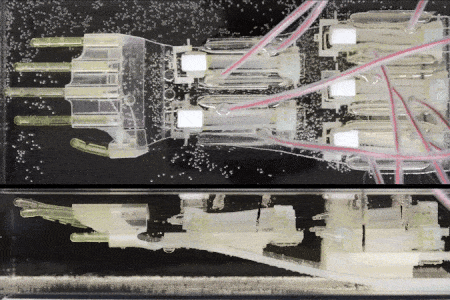Recent research on lightweight particles called neutrinos might have passed you by – much like the more than 10 trillion neutrinos passing through your body each second. Now, our new paper – with 21 countries, more than 60 institutes and around 360 scientists contributing – reports the observation of the most energetic neutrino yet.
Authors
- David Benoit
Senior Lecturer in Molecular Physics and Astrochemistry, University of Hull
- James Keegans
Teaching Fellow of Physics, University of Hull
Despite the enormous number of neutrinos around us, this is one of the most exciting – and rarest – astronomical events of the year. Our paper has been published in the journal Nature.
Neutrinos are tiny elementary (sub-atomic) particles that are abundant in our universe. Yet, you probably haven’t seen any. They do not interact with other matter in the ways we are familiar with.
Their lack of charge, for example, means that the electrostatic force that governs most of our everyday experiences does not interact with them at all. And their vanishingly small mass means that gravity – the other major force we experience – also has no effect on them in lab conditions on Earth.
So, detecting their presence is challenging to say the least.
Neutrinos can be produced in a huge number of environments. These include the radioactive decays of bananas , the interior of the Sun , during the violent death of a massive star and in the hot, dense disks of matter around supermassive black holes , to name just a few.
They are formed through the actions of the weak nuclear force, which governs radioactive decay. It is this force that enables positively charged particles called protons, which make up to atomic nucleus, to change into neutrons, neutrally charged particles which also exist in the atomic nucleus, and vice versa.
We cannot detect a neutrino directly. But, every now and then (although very rarely), they might bump into something. When that happens, through the action of this weak nuclear force, a charged particle, such as an electron, may be created – seemingly out of nowhere – that we can detect.
Those charged particles travel at enormous speeds. And when they move through a medium such as water, they create an eerie, faint blue glow as they are slowed down. This event, called the Cherenkov effect , also happens in nuclear reactor containment pools.
How likely (or unlikely) are these interactions? Well, you would have to flip 75 heads in a row on a fair coin to have the same probability of a single neutrino interacting with a particle of matter. Think this is easy? Go ahead and flip them. It’ll take a while.
Under the sea
The telescope collaboration uses this Cherenkov effect to scrutinise the depths of the Mediterranean Sea for the telltale faint glow of those neutrino events. They operate two huge detection stations – one off the shores of Toulon, France and one off the southern coast of Sicily. Scientists keep watch for events around the clock.
The scale of those detectors is gigantic, as are most neutrino detectors , since the only way of spotting the elusive neutrino collision is to try to increase the amount of matter that the neutrino can interact with. In fact, the KM3 part of the KM3NeT acronym stands for the kilometre cube (KM3) of seawater that the detector will be surveying when completed.
The detection stations themselves each consist of nearly 600 light detectors – spherical buoys each containing 31 light sensing tubes, which are attached to cables anchored to the seabed up to 3.5km below the surface.
The particle described in our recent paper was detected on February 13 2023. And you might wonder why the long wait? The intervening time has been spent by collaborators across Europe verifying and simulating the detection to confirm the nature of the event. After months of work by the KM3NeT team, we can finally say that this is the most energetic observation of a neutrino interaction ever recorded.
About 28,000 photons (light particles) were detected across the array in Sicily, indicating that a hugely energetic event had just happened. That said, an average 75W lightbulb generates millions and millions of photons every second (about 100 quintillion to be more precise). But while these few thousands of photons might appear to be a small event, remember that this has been generated by a single particle.
In fact, the energy of the neutrino responsible for such bright display was estimated to be 220 peta-electronvolts (PeV) or 30 times more energetic than the highest-energy neutrino recorded so far. In terms of particle energies, it is around 1,000 times more energetic than the particles generated at Cern, the most energetic accelerator facility in the world.
The light generated by this record-breaking event could be followed through the detector array and our collaboration was able to use it to reconstruct the near-horizontal trajectory of this high-energy neutrino. The path taken indicates that this neutrino is of cosmic origin.
We don’t know exactly where it comes from, but we’ve identified 12 potential blazars (bright cores of active galaxies) that may have produced it. It is also possible that it was created in the interaction of cosmic rays with photons from the cosmic energy background.
This detection provides a window into the ultra-high-energy phenomena happening in the universe and could, for example, help us better understand the nature of some of the most energetic cosmic rays. Moreover, the observation can help us further test the theoretical models that predict the existence of high-energy neutrinos.
![]()





